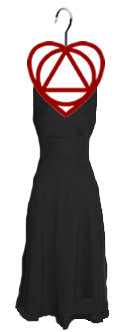
The Black Dress
by Beverly Ryle
We’d done it a hundred times before—gone shopping together. When we lived in Connecticut, my best friend Tina and I used to go off for the day together to Cold Spring, New York, a little town on the Hudson River where a designer who created clothes for high-end retailers like Neiman Marcus had an outlet store. 
At first we started going there mostly for the fun of seeing ourselves in something different, but with each visit we got more excited by the clothes and eventually began making carefully deliberated purchases.
We would first tour the store individually and then reconnoiter to show each other what we liked. In the first round of elimination, we would take armfuls of possibilities to the dressing room to try them on and critique each other’s choices based on fit, color and style.
For the second round, we would don our favorites again and analyze their potential for long-term use and enjoyment. When the process was completed we’d pay the store manager (who we came to know on a first name basis) and go out for a leisurely lunch.
In the remains of the day, we’d drive home enfolded in the gentleness of the afternoon sunlight, engaging in the sort of quieter, deeper dialogue which evolved from having enough time away from the noise of daily life to truly be together.
Like many best friends, Tina and I had developed a rhythm not just for shopping together, but for being together with immediacy and intimacy.
Our capacity to do this kicked in under a whole different set of circumstances last Christmas. It has become our custom since our mothers died to try to spend part of the holiday season together, so my husband and I had made our way down the New Jersey Turnpike to her home in the suburbs outside Philadelphia Christmas afternoon.
The next day, to have time alone as women and to satisfy the more urgent need of normalcy, we left the men watching television and went to take back a gift Tina had received from Talbot’s. We went to Talbot’s not to have to think or talk about what she had called to tell me two weeks earlier—a large mass had been found in her husband’s brain.
We knew we would be together through the difficult times to come, but we chose to stay in the moment, wondering if the navy blue pants would fit and the deep indigo in the paisley blouse would match.
We did what I have often observed in myself when I feel totally overwhelmed and decide to do the laundry and in other women when they turn to their knitting or quilting in times of stress.
We sustained ourselves with tactile rituals. We accessed the restorative comfort of touch, not only of another person, but of things.
At the store, we fell into our old routine of clicking through the racks and showing each other what we liked. Nothing between us was forced or artificial; we acted no different that day than on any other. We were not trying to make each other feel better, nor pretend the cancer diagnosis didn’t exist, which is no doubt why it made itself known in the little black dress.
On her way to the dressing room, Tina called me over to the petite section to look at a jersey-knit black dress with a delicately smocked bodice. I’m not sure exactly what she said—it might have been “Isn’t this pretty?” or “Isn’t this a great little black dress?”—and she said it just as she would have commented on any other item of clothing, yet it struck me that never before, in all our shopping excursions, had she ever been drawn to anything black.
In a flash I saw her in the dress, pale and small, standing next to a casket, surrounded by family members, a collection of photographs, distraught with grief, and looking at me, her friend, with swollen eyes, tearless because she had cried them dry.
As if to protect her—and myself—from the vision, I wanted to say something to stop her from buying the dress, but I couldn’t bring myself to talk about the obvious link between the black dress and a funeral.
Instead, I watched her try it on and listened to her talk to herself about where she might wear it and how versatile it might be. As she twirled around in the three-way mirror I tried not to let the effects of my vision show in my expression.
Finally, unable to act normal, I stepped out of the dressing room to escape from the heaviness of pretending we were just shopping.
The dress was still in her arms when we stood in the line to make our purchases, but she decided to put it on hold, which seemed to me to be a profoundly symbolic act. When I asked her (with a lump in my throat) a few weeks later if she had gone back for the black dress she said she decided she didn’t need it.
Since then I have told her what was going on for me that day. I’ve let her know how much I respect her and her husband’s decision to live in the present with the medical situation they have been given.
The blessings they receive and give to others by their example are in their day-to-day choice to live and love in the here and now. No special clothes are needed—although her husband is often seen wearing a “Life is Good” t-shirt.
 |
 |

Beverly Ryle is a regular contributor to this magazine and author of Ground of your own Choosing.
As a career counselor and business consultant, Beverly Ryle has been helping corporate professionals, business owners, and people-in-transition achieve their full potential for over 25 years.
She runs the Center for Career and Business Development in Eastham, MA 508 240 3532 www.successonyourownterms.com
An Invitation to Break Out of the Pack and Try Something Different!
To order go to:
Ground of Your Own Choosing
or
Amazon Books